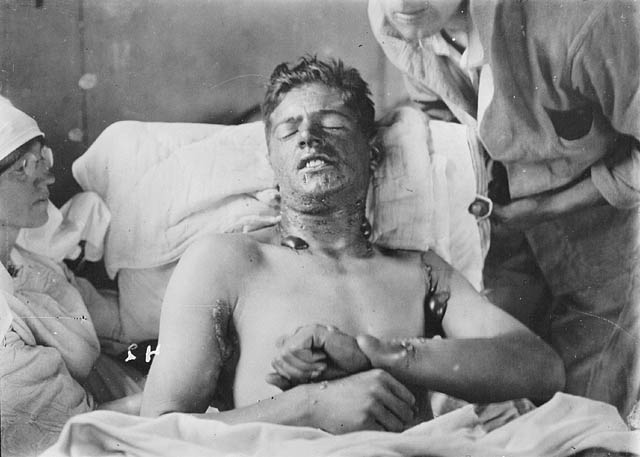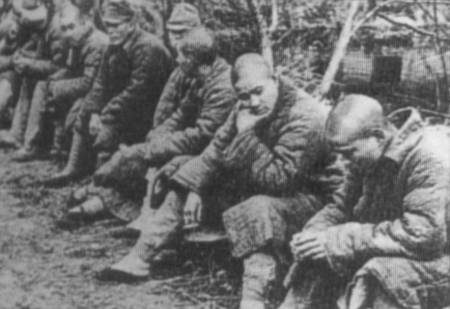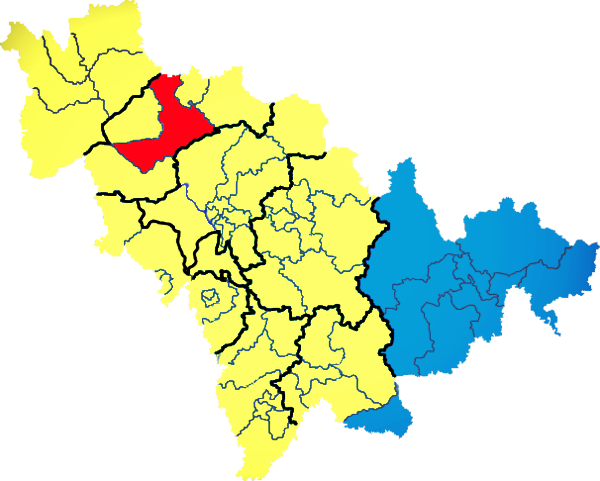|
Unit 516
Unit 516 (第五一六部隊) was a top secret Japanese chemical weapons facility, operated by the Kempeitai, in Qiqihar, Japanese-occupied northeast China. The name Unit 516 was a code name (Tsūshōgō) of the Unit. It was officially called the Kwantung Army Chemical Weapons Section and operated underneath Unit 731.Hal Gold, Unit 731 Testimony, 2003 An estimated 700,000 (Japanese estimation) to 2,000,000 (Chinese estimation) Japanese-produced chemical weapons were buried in China. Until 1995, Japan had refused to acknowledge that it dumped chemical weapons in the Nen River between Heilongjiang and Hulunbei'er, leaving huge amounts behind. Chemical weapons * Phosgene * Hydrogen cyanide * Bromobenzyl cyanide and Chloroacetophenone * Diphenylcyanoarsine and Diphenylchloroarsine * Arsenic trichloride * Sulfur Mustard * Lewisite At the end of World War II, the Imperial Japanese Army buried some of their chemical weapons in China, but most were confiscated by Soviet Red Army, t ... [...More Info...] [...Related Items...] OR: [Wikipedia] [Google] [Baidu] |
Chemical Weapon
A chemical weapon (CW) is a specialized munition that uses chemicals formulated to inflict death or harm on humans. According to the Organisation for the Prohibition of Chemical Weapons (OPCW), this can be any chemical compound intended as a weapon "or its precursor that can cause death, injury, temporary incapacitation or sensory irritation through its chemical action. Munitions or other delivery devices designed to deliver chemical weapons, whether filled or unfilled, are also considered weapons themselves." Chemical weapons are classified as weapons of mass destruction (WMD), though they are distinct from nuclear weapons, biological weapons, and radiological weapons. All may be used in warfare and are known by the military acronym NBC (for nuclear, biological, and chemical warfare). Weapons of mass destruction are distinct from conventional weapons, which are primarily effective due to their explosive, kinetic, or incendiary potential. Chemical weapons can be widely ... [...More Info...] [...Related Items...] OR: [Wikipedia] [Google] [Baidu] |
Sulfur Mustard
Mustard gas or sulfur mustard are names commonly used for the organosulfur chemical compound bis(2-chloroethyl) sulfide, which has the chemical structure S(CH2CH2Cl)2, as well as other species. In the wider sense, compounds with the substituents are known as ''sulfur mustards'' or '' nitrogen mustards'', respectively, where X = Cl or Br. Such compounds are potent alkylating agents, making mustard gas acutely and severely toxic. Mustard gas is a carcinogen. There is no preventative agent against mustard gas, with protection depending entirely on skin and airways protection, and no antidote exists for mustard poisoning. Also known as mustard agents, this family of compounds comprises infamous cytotoxins and blister agents with a long history of use as chemical weapons. The name ''mustard gas'' is technically incorrect; the substances, when dispersed, are often not gases but a fine mist of liquid droplets that can be readily absorbed through the skin and by inhalation. The ski ... [...More Info...] [...Related Items...] OR: [Wikipedia] [Google] [Baidu] |
Changde Chemical Weapon Attack
The Battle of Changde (Battle of Changteh; ) was a major engagement in the Second Sino-Japanese War in and around the Chinese city of Changde (Changteh) in the province of Hunan. The purpose of the Japanese offensive was to maintain pressure on the Chinese National Revolutionary Army to reduce its combat ability in the region and its ability to reinforce the Burma Campaign. The Japanese were initially successful in their offensive operation by bacteria-infected bombs and captured parts of the city of Changde, which forced civilians to evacuate. The Japanese were pinned down in the city by a Chinese division long enough for other Chinese units to surround them with a counterencirclement. Heavy casualties and the loss of their supply lines then forced the Japanese to withdraw, which returned territorial control to the original status quo. Some contemporary Western newspapers depicted the battle as a Chinese victory. American government film footage showed victorious Chinese ... [...More Info...] [...Related Items...] OR: [Wikipedia] [Google] [Baidu] |
Chemical Weapons Convention
The Chemical Weapons Convention (CWC), officially the Convention on the Prohibition of the Development, Production, Stockpiling and Use of Chemical Weapons and on their Destruction, is an arms control treaty administered by the Organisation for the Prohibition of Chemical Weapons (OPCW), an intergovernmental organization based in The Hague, Netherlands. The treaty entered into force on 29 April 1997. It prohibits the use of chemical weapons, and the large-scale development, production, stockpiling, or transfer of chemical weapons or their precursors, except for very limited purposes (research, medical, pharmaceutical or protective). The main obligation of member states under the convention is to effect this prohibition, as well as the destruction of all current chemical weapons. All destruction activities must take place under OPCW verification. 193 states have become parties to the CWC and accept its obligations. Israel has signed but not ratified the agreement, while three o ... [...More Info...] [...Related Items...] OR: [Wikipedia] [Google] [Baidu] |
Jilin
) , image_skyline = Changbaishan Tianchi from western rim.jpg , image_alt = , image_caption = View of Heaven Lake , image_map = Jilin in China (+all claims hatched).svg , mapsize = 275px , map_alt = Map showing the location of Jilin Province , map_caption = Map showing the location of Jilin Province , coordinates = , subdivision_type = Country , subdivision_name = China , named_for = from ''girin ula'', a Manchu language, Manchu phrase meaning "along the river" , seat_type = Capital , seat = , seat1_type = , seat1 = , parts_type = Divisions , parts_style = para , p1 = 9 Prefectures of China, prefectures , p2 = 60 Counties of China, counties , p3 = 1006 Townships of China, townships , government_type = Provinces of China, Province , governing_body = Jilin Provinci ... [...More Info...] [...Related Items...] OR: [Wikipedia] [Google] [Baidu] |
Dunhua
Dunhua (; Korean: ) is a county-level city of the Yanbian Korean Autonomous Prefecture in southeastern Jilin province, China. It has more than 480,000 inhabitants (as of 2002) and was the capital of Balhae between 742 and 756, known at the time as "Junggyeong". During the Qing dynasty it was called Áodōng () in Chinese and ''Odoli'' in Manchu. Geography and climate Dunhua is situated amongst the Changbai Mountains, its administrative area spanning 42°42′−44°30′ N latitude and 127°28′−129°13′ E longitude, reaching a maximal north–south extent of and east–west width of . Its total area of makes it, by area, the largest county-level city of the province. Dunhua has a four-season, monsoon-influenced, humid continental climate (Köppen ''Dwb''), with long, very cold winters, and short, but warm, humid summers. Spring and autumn constitute very short transitions with some, but usually not heavy, rainfall. The monthly 24-hour average temperature ranges from in ... [...More Info...] [...Related Items...] OR: [Wikipedia] [Google] [Baidu] |
Republic Of China
Taiwan, officially the Republic of China (ROC), is a country in East Asia. The main geography of Taiwan, island of Taiwan, also known as ''Formosa'', lies between the East China Sea, East and South China Seas in the northwestern Pacific Ocean, with the China, People's Republic of China (PRC) to the northwest, Japan to the northeast, and the Philippines to the south. It has an area of , with mountain ranges dominating the eastern two-thirds and plains in the western third, where its Urbanization by country, highly urbanized population is concentrated. The combined Free area of the Republic of China, territories under ROC control consist of list of islands of Taiwan, 168 islands in total covering . The Taipei–Keelung metropolitan area, largest metropolitan area is formed by Taipei (the capital), New Taipei City, and Keelung. With around 23.9 million inhabitants, Taiwan is among the List of countries and dependencies by population density, most densely populated countries. Tai ... [...More Info...] [...Related Items...] OR: [Wikipedia] [Google] [Baidu] |
Soviet Union
The Union of Soviet Socialist Republics. (USSR), commonly known as the Soviet Union, was a List of former transcontinental countries#Since 1700, transcontinental country that spanned much of Eurasia from 1922 until Dissolution of the Soviet Union, it dissolved in 1991. During its existence, it was the list of countries and dependencies by area, largest country by area, extending across Time in Russia, eleven time zones and sharing Geography of the Soviet Union#Borders and neighbors, borders with twelve countries, and the List of countries and dependencies by population, third-most populous country. An overall successor to the Russian Empire, it was nominally organized as a federal union of Republics of the Soviet Union, national republics, the largest and most populous of which was the Russian SFSR. In practice, Government of the Soviet Union, its government and Economy of the Soviet Union, economy were Soviet-type economic planning, highly centralized. As a one-party state go ... [...More Info...] [...Related Items...] OR: [Wikipedia] [Google] [Baidu] |
Republic Of China Army
The Republic of China Army ( Chinese, 中華民國陸軍) also known as the ROC Army (ROCA); colloquially the Taiwanese Army ( Chinese, 台湾陆军) by western or mainland Chinese media, or commonly referred as the National Military Army ( Chinese, 國軍陸軍) by local Taiwanese people, is the largest branch of Taiwan's military, the Republic of China (Taiwan) Armed Forces. An estimated 80% of the ROCA is based on the Main Island of Taiwan, while the remainder are stationed on the Penghu, Kinmen, Matsu, Dongsha, and Taiping Islands. This branch was also referred to historically as the Chinese Army and the Nationalist Chinese Army during and after World War II and the 1949 retreat. Since the Chinese Civil War, no armistice or peace treaty has ever been signed between the Republic of China regime and the communist regime, so as the final line of defense against a possible invasion by the People's Liberation Army (PLA), the primary focus of the ROCA is on defense and ... [...More Info...] [...Related Items...] OR: [Wikipedia] [Google] [Baidu] |
People's Liberation Army
The People's Liberation Army (PLA) is the military of the Chinese Communist Party (CCP) and the People's Republic of China (PRC). It consists of four Military branch, services—People's Liberation Army Ground Force, Ground Force, People's Liberation Army Navy, Navy, People's Liberation Army Air Force, Air Force, and People's Liberation Army Rocket Force, Rocket Force—and four arms—People's Liberation Army Aerospace Force, Aerospace Force, People's Liberation Army Cyberspace Force, Cyberspace Force, People's Liberation Army Information Support Force, Information Support Force, and People's Liberation Army Joint Logistics Support Force, Joint Logistics Support Force. It is led by the Central Military Commission (China), Central Military Commission (CMC) with its Chairman of the Central Military Commission (China), chairman as Supreme Military Command of the People's Republic of China, commander-in-chief. The PLA can trace its origins during the Republic of China (1912– ... [...More Info...] [...Related Items...] OR: [Wikipedia] [Google] [Baidu] |
Red Army
The Workers' and Peasants' Red Army, often shortened to the Red Army, was the army and air force of the Russian Soviet Republic and, from 1922, the Soviet Union. The army was established in January 1918 by a decree of the Council of People's Commissars to oppose the military forces of the new nation's adversaries during the Russian Civil War, especially the various groups collectively known as the White Army. In February 1946, the Red Army (which embodied the main component of the Soviet Armed Forces alongside the Soviet Navy) was renamed the "Soviet Army". Following the dissolution of the Soviet Union it was split between the post-Soviet states, with its bulk becoming the Russian Ground Forces, commonly considered to be the successor of the Soviet Army. The Red Army provided the largest land warfare, ground force in the Allies of World War II, Allied victory in the European theatre of World War II, and its Soviet invasion of Manchuria, invasion of Manchuria assisted the un ... [...More Info...] [...Related Items...] OR: [Wikipedia] [Google] [Baidu] |



